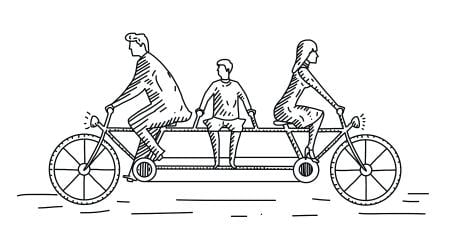Abstract
The nascent field of gender-affirming surgery (GAS) for binary and nonbinary transgender adolescents is growing rapidly, and the optimal use of shared decision making (SDM)—including who should be involved, to what extent, and for which parts of the decision—is still evolving. Participants include the adolescent (whose goals might center on aesthetics and functionality), the surgeon (who might focus more on minimizing complications), the referring clinician (whose participation is mandated by present standards of care), and the caregiver (whose participation is required for patients below the age of consent). This article argues that effective, ethical SDM in adolescent GAS care requires a different conceptualization of roles than might be expected in other situations and should be a longitudinal experience rather than a singular event.
Adolescent Gender Surgery Decisions
Gender affirmation is, fundamentally, the use of social, medical, and surgical processes to reify individuals’ sense of themselves as a gendered being. The nascent field of gender-affirming surgery (GAS) is growing rapidly, particularly in its understanding of optimal techniques and outcomes. This is especially true for adolescent surgeries, as the existing literature predominantly focuses on adults,1 which is in line with clinical practice guidelines that presently recommend gender-affirming genital surgeries be deferred until the age of majority.2,3 However, both the World Professional Association for Transgender Health’s Standards of Care for the Health of Transsexual, Transgender, and Gender-Nonconforming People and the Endocrine Society’s clinical practice guidelines, Endocrine Treatment of Gender-Dysphoric/Gender-Incongruent Persons, state that chest surgery may be performed prior to the age of majority depending on the individual,2,3 and a number of surgeons acknowledge performing genital surgeries prior to age of majority.4 In addition, many individuals seek GAS shortly after reaching the age of majority, which suggests that most counseling has already occurred.
Conversations concerning patients’ and clinicians’ expectations for GAS are often fraught. Patients might have goals centered on aesthetics and functionality while surgeons might focus more on minimizing complications.5 There are also inherent power imbalances in these conversations, in part due to differences in age and training, and, in moments of conflict, patients might subordinate their needs and goals to those of the seemingly omniscient surgeon. As such, decision making about the surgical goal might be characterized less by 2 persons “sharing” than by 2 persons talking past one another. Ultimately, the patient hopes the surgeon knows what’s right and the surgeon that the patient knows what’s acceptable. Shared decision making (SDM) is made more complex by referring clinicians, whose participation is mandated by present standards of care, and the caregiver, whose participation is required for patients below the age of consent.2,3 For all these reasons, the optimal use of SDM—including who should be involved, to what extent, and for which parts of the decision—continues to evolve.
How does SDM work in a field like adolescent GAS in which everyone has very different perspectives, no one participant has all the information, and the information that parties hold might seem to conflict? We argue that effective, ethical SDM concerning adolescent GAS requires taking into account a number and variety of factors and participants. By evaluating the nuances of each participant’s perspective, as well as the social context for gender-affirming care, we demonstrate the ways in which SDM for adolescent GAS is different than in other areas of adolescent health. We also make the case for regarding SDM as an ongoing, longitudinal process rather than as a single, isolated event.
Surgeons’ Roles
As a new field, GAS is characterized by limited longitudinal data, rapidly evolving standards, and ongoing disputes about optimal approaches.6 Surgeons desire to utilize techniques that minimize morbidity and maximize patient satisfaction yet are constantly faced with new procedures, such as for transgender neophallus construction.7 It is even more complex to assess functional outcomes, as function is integral to patients’ experiences of their gendered body, sexuality, and place in society.
The surgeon’s perspective is often additionally limited by personal experience. Many surgeons are cisgender, have not experienced gender dysphoria, were raised in a world in which gender was binary, and trained at a time when GAS was used to cross from one anatomically defined end of this binary to the other.8,9 During SDM, the surgeon might come to the table focused entirely on how to accomplish the best possible cisgender, endosex, and heteronormative functioning of their patient’s neogenitalia. Making a heterosexual binary identity the default goal of surgical transition leads surgeons to see the ideal vaginoplasty, for example, as one with depth that supports phallic penetration.10 Any deviations from the default goal might be considered compromising modifications. Correspondingly, the default goal risks devaluing the needs of patients—for example, the needs of a nonbinary patient whose goals for chest surgery include a chest flat enough to bind comfortably but one that does not mimic a male contour. Thus, defaulting to mimicry of archetypical, cisgender bodies fails to take into consideration what individual patients view as their ideal.
Surgeons’ recommendations must be put in a broader context. Just as diversity in gender and sexual orientation is no longer pathologized by some medical organizations,11,12 so functional and aesthetic ideals for genital functioning must be more clearly interrogated by policymakers and legislators.12,13 Additionally, in a rapidly growing field, it’s impossible to completely know what future improvements are forthcoming.14 Therefore, it’s important for other participants in SDM to acknowledge the limitations of surgeons’ recommendations—particularly if they’re favoring newer practices over old, but also if they’re privileging established standards over promising advances.
Nevertheless, in SDM, surgeons must bring their expertise to the table. They understand and can communicate what any given surgery can and cannot provide, as well as its associated risks. Surgeons should not assume they know the ideal outcome for any given patient but should use their experience to determine if a patient’s stated ideal is realistic—or even currently possible— and advise on how best to meet the patient’s goals.
Adolescent Patients’ Roles
If surgeons bring procedural expertise to SDM, adolescents bring expertise in their identities and lives. They know, better than anyone else, who they are and what it is like for them to move through the world. They have the clearest picture of their GAS goals—their ideal aesthetic and functional outcomes. They might have a more nuanced understanding of the intersections between sex, gender, and anatomy than their parents and clinicians, who often have expectations for binary identity. They might also, with access to support and online information, have an understanding of the risks and possibilities of GAS that is equal to—or better than—that of physicians they consult.
Adolescents know, better than anyone else, who they are and what it is like for them to move through the world.
However, they are also adolescents. Their brains are not yet fully mature, and they do not have the same capacity as adults to regulate impulses and weigh risks and rewards.15 They might not have the ability to determine the accuracy of information they’ve accessed.16 Their understanding of their gender identity and expression, sexuality, and anatomy might still be evolving. While it is important for clinicians and caregivers to accept adolescents as experts about their own lives and to afford them as much autonomy as possible, it is also important to acknowledge that they might have difficulty understanding complex information and making appropriate decisions. The adults engaged in SDM might have certain skills that the adolescent lacks, but they are also imperfect predictors and deciders. In SDM, adolescents’ ideal role is to describe the goal of their gender transition journey while the adults help them identify the best route to take.
Caregivers’ Roles
For adolescents below the age of majority, caregivers play a critical role in SDM. Despite this process being fundamentally about the adolescent medically affirming their self-perception of identity, caregivers are responsible for consent and thus are expected to balance the needs of the adolescent and their own theoretically greater understanding of potential long-term consequences and contexts.17 It is their duty to simultaneously support their child’s growing autonomy while recognizing any limitations to that child’s ability to appropriately enact it.
Caregivers of gender diverse children have various experiences with and feelings about their child’s gender transition journey.18 They might be supportive, or they might put up roadblocks.19 They might feel like reluctant passengers on a gender transition journey they feel is moving too fast, or they might be driving the child’s transition to address their own insecurities and needs. Ideally, caregivers are supportive copilots in the SDM process. Having the best interests of their child in mind, they bring knowledge of the adolescent and a mature understanding of the situation to the process of making rational decisions.18 Nevertheless, they might have personal objections (ie, religious, cultural) to gender diverse identities or fears about stigma in their child’s future, which could complicate their decision making.18,20
It is critical for clinicians to encourage caregivers to consider their child’s best interest and to be flexible during surgical decision-making processes. In some cases, it might make more sense for an adolescent to forego GAS until adulthood than to be steered by caregivers into an inappropriate surgical decision that will need readdressing in the future. When caregivers are clearly unable to act in the best interest of the patient, alternative gender-affirming pathways might need to be explored. At other times, clinicians, caregivers, and adolescents can work together on a compromise that is not ideal for anyone but functional for all, such as when parents of transmasculine youth are willing to consent to chest reconstruction surgery but not to gender-affirming hormone therapy to address their child’s dysphoria.
Referring Clinicians’ Roles
Referring clinicians are usually the first to discuss GAS with families and patients. The Endocrine Society’s clinical practice guidelines, Endocrine Treatment of Gender-Dysphoric/Gender-Incongruent Persons, recommend participation of clinicians providing endocrine transition therapy in the surgical readiness referral process, which might make them the first clinicians to have conversations about surgery with their patients who want it.3 Different types of referring clinicians might also serve as gatekeepers to surgeons. Patients might require a referral from the clinician who prescribes their hormones or from a primary care physician to even access a surgical consult, and the current World Professional Association for Transgender Health’s Standards of Care requires mental health professionals to provide readiness letters to surgeons in order for patients to move forward through their surgical journey.2,3 For this reason, mental health professionals might also be the first clinicians to engage in a dialogue about surgical options, outcomes, and choices, even when these conversations are not required for referral.
Despite the role they have in helping patients access surgery, referring clinicians rarely remain involved in the decision-making process once letters have been written or referrals made, except in situations in which surgeons need to coordinate complexities of care. Referring clinicians are thus simultaneously omnipresent and absent from the SDM conversation.
Conclusion
In adolescent GAS care, SDM is not a singular event but a longitudinal experience. It starts with the patient’s desire for gender affirmation and leads to interactions with caregivers and referring clinicians, even before a surgeon is identified. SDM continues through surgical consultation and into the recovery period when ongoing concerns must be addressed. For SDM to be ethical and successful, it is important to acknowledge that no one participant should shape the discussion throughout the gender transition journey. Each has their own viewpoint and expertise. The ideal SDM process is one in which everyone comes to an agreement on the goal and best path forward.
Ultimately, it is critical for clinicians to allow themselves to be humble and to acknowledge patients’ understanding of their gender and its alignment with their anatomy. It is important for caregivers and clinicians to balance respect for patients’ autonomy and a realistic assessment of any limitations in patients’ decision-making processes. It is also essential for patients and their caregivers to acknowledge that, while GAS can accomplish some goals, it is not the golden ticket to solving all problems related to gender affirmation. Everyone involved in SDM must realize that it is possible to make the best possible informed decision and still have some regret, because the current reality of GAS is that it is almost never the perfect option, even when it is the best possible one.
References
- Dreher PC, Edwards D, Hager S, et al. Complications of the neovagina in male-to-female transgender surgery: a systematic review and meta-analysis with discussion of management. Clin Anat. 2018;31(2):191-199.
- Coleman E, Bockting W, Botzer M, et al. Standards of care for the health of transsexual, transgender, and gender-nonconforming people, version 7. Int J Transgend. 2012;13(4):165-232.
- Hembree WC, Cohen-Kettenis PT, Gooren L, et al. Endocrine treatment of gender-dysphoric/gender-incongruent persons: an Endocrine Society clinical practice guideline. J Clin Endocrinol Metab. 2017;102(11):3869-3903.
-
Perović S. Phalloplasty in children and adolescents using the. extended pedicle island groin flap. J Urol. 1995;154:848-853.
-
Remington AC, Morrison SD, Massie JP, et al. Outcomes after phalloplasty: do transgender patients and multiple urethral procedures carry a higher rate of complication? Plast Reconstr Surg. 2018;141(2):220e-229e.
- Sutcliffe PA, Dixon S, Akehurst RL, et al. Evaluation of surgical procedures for sex reassignment: a systematic review. J Plast Reconstr Aesthet Surg. 2009;62(3):294-306.
-
Frey JD, Poudrier G, Chiodo MV, Hazen A. A systematic review of metoidioplasty and radial forearm flap phalloplasty in female-to-male transgender genital reconstruction: is the “ideal” neophallus an achievable goal? Plast Reconstr Surg Glob Open. 2016;4(12):e1131.
-
Bergner D. The struggles of rejecting the gender binary. New York Times Magazine. June 4, 2019. https://www.nytimes.com/2019/06/04/magazine/gender-nonbinary.html. Accessed August 29, 2019.
- Scheim AI, Appenroth MN, Beckham SW, et al. Transgender HIV research: nothing about us without us. Lancet HIV. 2019;6(9):e566-e567.
-
Hess J, Henkel A, Bohr J, et al. Sexuality after male-to-female gender affirmation surgery. BioMed Res Int. 2018;2018:9037979.
- Vance SR Jr, Cohen-Kettenis PT, Drescher J, Meyer-Bahlburg HFL, Pfäfflin F, Zucker KJ. Opinions about the DSM gender identity disorder diagnosis: results from an international survey administered to organizations concerned with the welfare of transgender people. Int J Transgend. 2010;12(1):1-14.
- Stroumsa D. The state of transgender health care: policy, law, and medical frameworks. Am J Public Health. 2014;104(3):e31-e38.
-
World Health Organization Regional Office for Europe. Moving one step closer to better health and rights for transgender people. http://www.euro.who.int/en/countries/belarus/news/news/2019/05/moving-one-step-closer-to-better-health-and-rights-for-transgender-people. Published May 17, 2019. Accessed August 29, 2019.
- Jones BP, Williams NJ, Saso S, et al. Uterine transplantation in transgender women. BJOG. 2019;126(2):152-156.
-
Arain M, Haque M, Johal L, et al. Maturation of the adolescent brain. Neuropsychiatr Dis Treat. 2013;9:449-461.
-
Vargas CR, Ricci JA, Lee M, Tobias AM, Medalie DA, Lee BT. The accessibility, readability, and quality of online resources for gender affirming surgery. J Surg Res. 2017;217:198-206.
- Simons L, Schrager SM, Clark LF, Belzer M, Olson J. Parental support and mental health among transgender adolescents. J Adolesc Health. 2013;53(6):791-793.
- Dierckx M, Motmans J, Mortelmans D, T’sjoen G. Families in transition: a literature review. Int Rev Psychiatry. 2016;28(1):36-43.
-
Bauer GR, Scheim AI, Pyne J, Travers R, Hammond R. Intervenable factors associated with suicide risk in transgender persons: a respondent driven sampling study in Ontario, Canada. BMC Public Health. 2015;15(1):525.
- Gibbs JJ, Goldbach J. Religious conflict, sexual identity, and suicidal behaviors among LGBT young adults. Arch Suicide Res. 2015;19(4):472-488.



